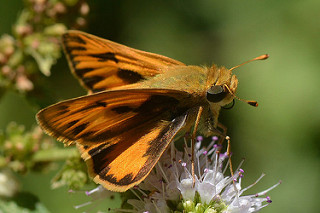This entry is from Isabella Messer, and undergraduate horticulture student at Oregon State University. It highlights a common Oregon pollinator.

As winter starts to wind down, daffodils and crocuses begin to emerge, and butterfly enthusiasts start looking forward to another season of spotting some of my favorite pollinators, the Lepidoptera. While peak butterfly season still may be a ways off(5), there is no reason to delay in learning about and exploring the world of butterflies, as I have been doing these last few days with Ochlodes sylvanoides(Boisduval, 1852), or the Woodland Skipper.
These little beauties can be identified by their tawny upperwings which sport a black border and large red patches on their underside(1,2). The hindwings of the Woodland Skipper can vary greatly from being unmarked to being yellow or even showing a chevron pattern(1, 2).
Woodland Skippers are native to Oregon and in fact, are native to most of the western United States. With a range that stretches from South Dakota to Oregon and from Vancouver, BC to San Diego, CA, Skippers are one of the most abundant butterfly genera in the US(6,2). The preferred habitats of Woodland Skippers include grassy areas in chaparral, mountain meadows, and hillsides(1). For those of you living among

With Portland’s many hills, it seems likely that your garden would be an appealing place for these butterflies to make their home. If you are looking to attract some Woodland Skippers to your garden, this may not be terribly hard as O. sylvanoides are generalists. Larval food plants consist largely of common grasses such as bermuda, wildrye, wheatgrass, and canary(1,2). Adult food plants can vary widely, from Oregon natives such as yarrow, sweet pea, and willowherb to others such as catmint, tansy, and zinnia(1). If you are having a slow start to your gardening season and have lots of patches of exposed dirt, that is okay seeing as adult Woodland Skippers will also sip salts from mud puddles(1).
Keep the hope of summer and Woodland Skippers in your garden alive, as this winter season begins to come to an excruciating close, and when August(3,4) finally rolls around, keep your eyes open for these tawny beauties.
References
- Lotts, Kelly and Thomas Naberhaus, et al. “Woodland Skipper”. Butterflies and Moths of North America. 2017. Butterflies and Moths of North America. http://www.butterfliesandmoths.org/
- Woodland Skipper — Ochlodes sylvanoides. Montana Field Guide. Montana Natural Heritage Program. Retrieved on February 22, 2018, from http://FieldGuide.mt.gov/speciesDetail.aspx?elcode=IILEP72010
- Allen, Nancy., et al. “Create a Butterfly Garden”. 2002. http://ir.library.oregonstate.edu/concern/administrative_report_or_publications/kd17ct04f
- Chu, Janet R.. “Butterflies A Continuing Study of Species and Populations In Boulder County Open Space Properties – 2011 Inventory and 2007-2011 Analyses”. Boulder County Parks and Open Space and Boulder County Nature Association. Dec. 2011. https://assets.bouldercounty.org/wp-content/uploads/2017/03/research-report-2011Chu.pdf.
- Kaufman, Kenn. “Year-round Guide to Butterflies”. Birds and Blooms. 2016.http://www.birdsandblooms.com/gardening/attracting-butterflies/year-round-guide-butterflies/
- Department of Systematic Biology, Entomology Section, National Museum of Natural History, in cooperation with Public Inquiry Services Information Sheet Number 189. “Butterflies in the United States”. Smithsonian. https://www.si.edu/spotlight/buginfo/butterflyus




